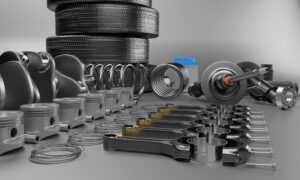Technological innovations have stirred competition and growth in nearly every industry, from healthcare to education to automotive. The motor industry, in particular, has seen advancements in AI and smart technology change the face of motorized vehicles. As autonomous automobiles become a thing of the present instead of a future innovation, the door has opened, and transportation has shifted drastically.
With hardware production and tech features running at near-peak performance, automobile software continues to advance with no sign of slowing down. Software development represents a vast frontier where advancements occur in leaps and bounds on an almost daily basis.
From production processes to navigation systems, automation is the key, and the sky’s the limit. It’s no longer a question of where the automobile industry needs to focus its efforts but how far executives are willing to go.
SCADA systems
Supervisory Control and Data Acquisition (SCADA) capabilities allow for significant improvements in automotive production capabilities. SCADA control systems help streamline IT services and device functionality by gathering real-time data, increasing production and monitoring efforts.
SCADA systems bridge the gap between your front-end equipment and existing software applications, bringing all systems under one roof for easier management and control. With a user-friendly interface and impressive data collection features, it’s easy to improve existing production processes and maintain efficiency.
Developing automation options for automobile manufacturing is a sure-fire way to expand by streamlining production and shortening delivery times. Automotive industry leaders can harness the power of instrumentation and controls integrators like Telstar Instruments, who offer round-the-clock cost-effective services.
Car safety software
Car safety features can save your life, making them a top consideration for many buyers. However, today, it takes more than safety belts and airbags to impress drivers. Advanced car safety features, like forward-collision warnings, lane-keeping assistance, and blind-spot warnings, can easily sway customers. These automated features trigger alerts and guide drivers reducing the chances of collisions, drifting, and back-up accidents.
Using software to integrate adaptive technology can prevent collisions and improve the driving experience. Safety add-ons may cost more up-front, but buyers are still eager to utilize features, as they create a safer driving environment and can save them money on insurance premiums.
Garage management systems
From general upkeep to necessary repairs, maintenance shops keep cars up and running. Shops that upgrade their software frequently can offer customers incentives, like quick turn-around time and improved mechanical features.
Management software allows repair shops to streamline customer service, which keeps business booming. Technicians can provide more accurate estimates, build invoices, create work orders, and maintain an inventory with one system. Furthermore, management can utilize software upgrades to handle bookkeeping and organize customer information.
Advanced automation is the future of automobile maintenance and creates endless opportunities for auto-repair garages. By reducing human error, boosting productivity, and enhancing communication between customers and technicians, the software can improve a workshop’s bottom line.
Navigation software
Currently, navigational software used in motor vehicles links to satellite navigation devices to determine your location in real-time. However, limited information and sub-par network capabilities limit satnav technology, meaning systems may not recognize new routes or changes in traffic patterns.
Though navigational software is a staple in most modern cars, there’s room for improvement. Imagine the effects of a more intuitive system that flawlessly navigates you through town, bypassing slow traffic, accidents, and road work without missing a beat. With new and improved navigation technology, the possibilities are endless.
Autopilot Software
Though the safety of self-driving cars remains a hot topic, it’s undoubtedly a technological marvel. In terms of advanced automation software, autopilot technology is still in its infancy. However, the goal is to create a program allowing vehicles to drive passengers to their destination safely. Essentially, a driver tells the car where they want to go, then sits back and enjoys the ride.
Autopilot software poses potential solutions to short, regular trips, like home to work and back, and long-distance excursions that can exhaust a driver. Of course, auto-navigation software is complex and will require thorough testing and regulatory measures to ensure safety.
Communication software
Talking or texting on your phone while driving isn’t just frowned upon— it’s illegal in most places. While on the road, handling a mobile device is dangerous and potentially deadly, causing six times more accidents per year than intoxicated driving.
Because of continued phone usage and increased roadway accidents, automotive manufacturers sought to bridge the gap between communication and safe driving. Bluetooth connectivity in vehicles allows for hands-free calling and speech-to-text capabilities, allowing users to communicate while keeping their attention on the road ahead.
Entertainment software
Entertainment software is becoming a critical feature for many car buyers. Cassette decks, CD players, and AM/FM radios are out-of-date novelties. Now, the expectation is Bluetooth connectivity and Wi-Fi hotspots. New entertainment applications make car time more manageable and more productive than ever. Drivers can stream music online or listen to audiobooks on the way to work, passengers can connect to Wi-Fi hotspots to complete work, and parents can improve long road trips with built-in TV screens for restless kiddos.
Software is the automotive industry’s future
When it comes to software solutions, the automotive industry has multiple avenues to explore. From self-driving cars to crash assistance to streamlined Bluetooth features, the future is intuitive and adaptive. Ultimately, new-and-improved software streamlines production time, increases safety features, and offers drivers a better in-car experience.



































